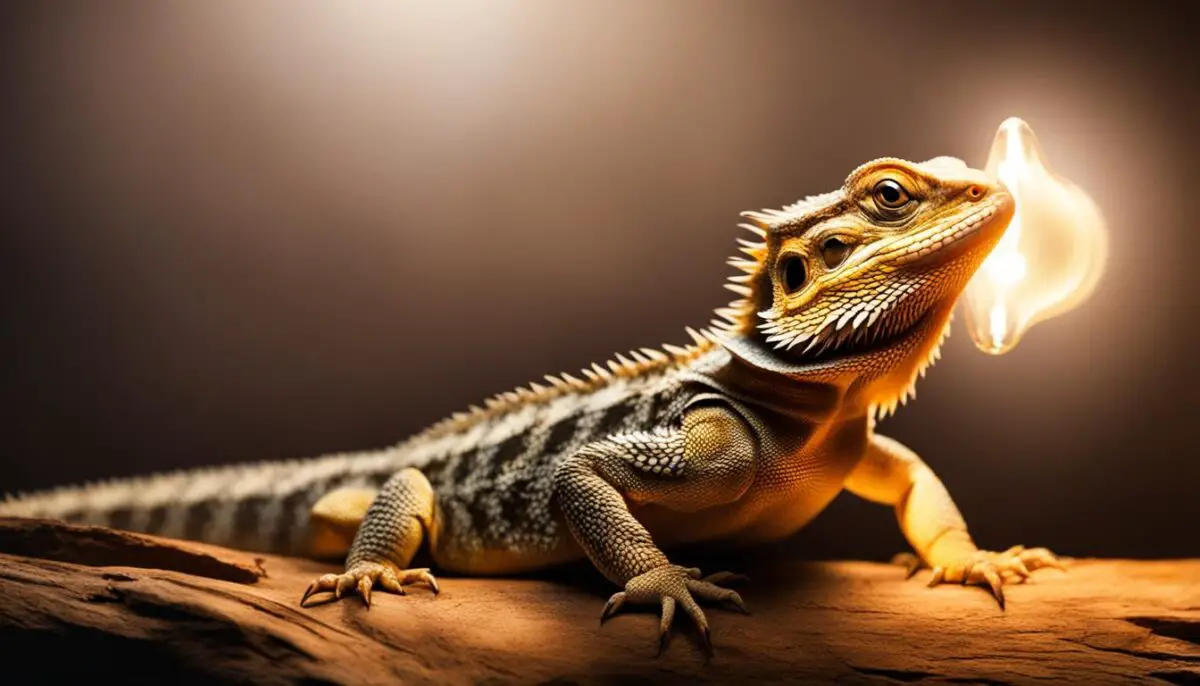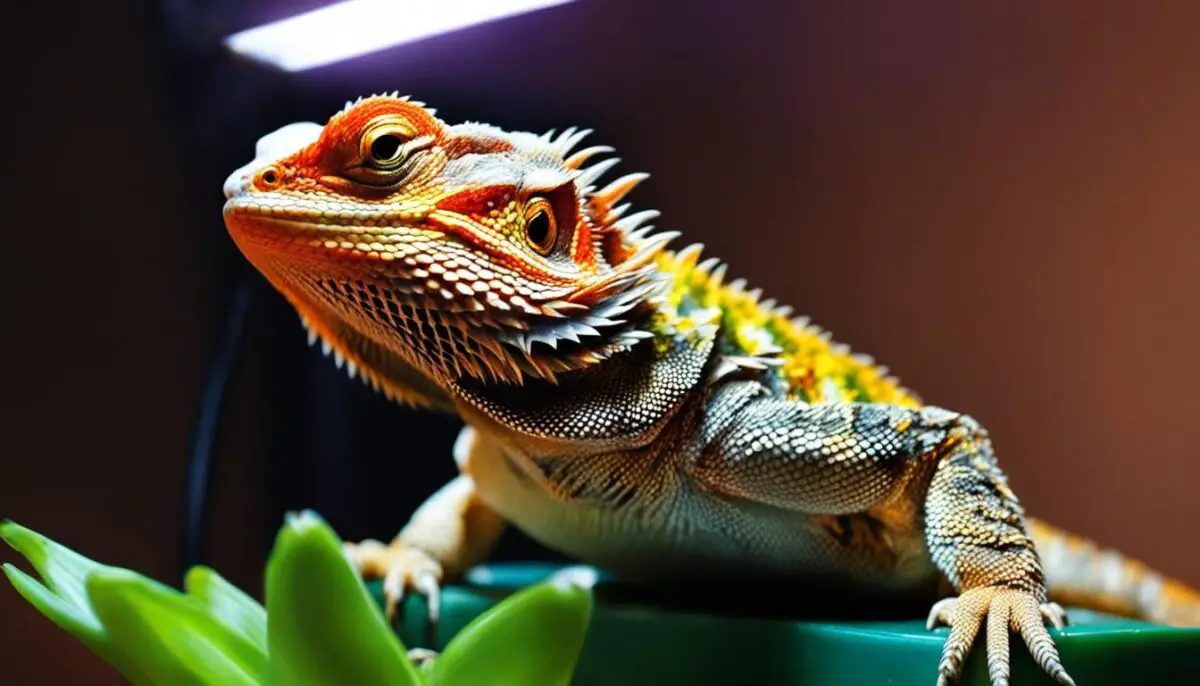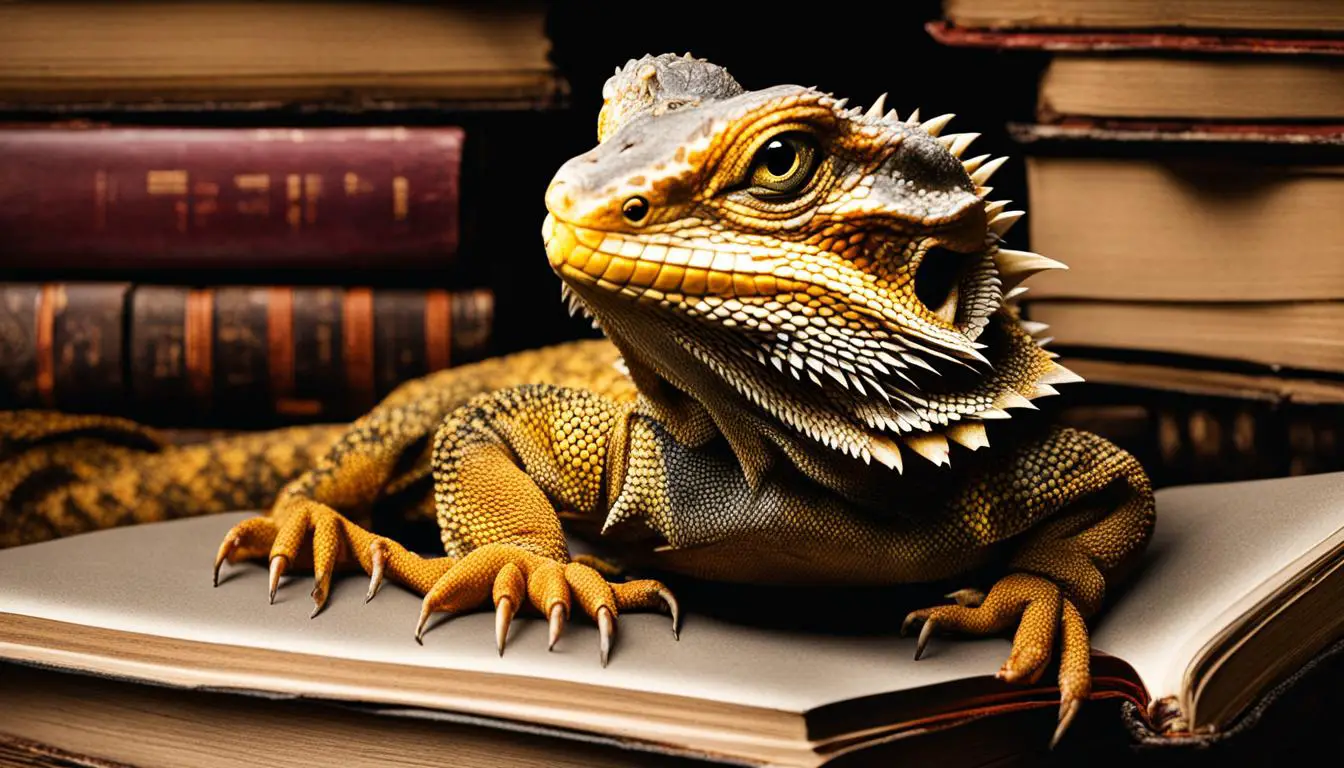Welcome to ReptiFiles, your ultimate resource for everything related to bearded dragons! Whether you’re a new owner or a seasoned reptile enthusiast, this comprehensive guide will provide you with all the information you need to ensure the health and happiness of your bearded dragon.
Bearded dragons, scientifically known as Pogona vitticeps, are fascinating creatures native to Australia. They are diurnal lizards commonly found in deserts, scrublands, and forests. With their distinctive spiky throat pouch, or beard, they make a striking and captivating pet.
One of the reasons bearded dragons have become so popular as pets is their calm temperament and social behaviors. They are known to recognize their keepers, enjoy social interactions, and even respond to their names. Let’s dive into the world of bearded dragon care to ensure you can provide the best possible environment for your scaly friend.
Key Takeaways:
- Bearded dragons, also known as Pogona vitticeps, are agamid lizards native to Australia.
- They are diurnal creatures that can be found in various habitats such as deserts, scrublands, and forests.
- Bearded dragons are omnivorous, feeding on both plants and insects.
- They have an average length of 18″-24″ and a lifespan of 10-15 years.
- Bearded dragons come in a variety of colors and scale textures due to modern breeding practices.
Bearded Dragon Habitat and Setup
To create a suitable habitat for a bearded dragon, you’ll need a large terrarium with appropriate lighting and heating. The terrarium should be at least 40 gallons in size for an adult bearded dragon.
Here’s a breakdown of the essential components for a bearded dragon setup:
- Terrarium Size: The terrarium should provide ample space for your bearded dragon to roam and explore. A minimum of 40 gallons is recommended for adult dragons, but larger enclosures are even better.
- Temperature Gradient: Bearded dragons require a temperature gradient in their habitat to regulate their body temperature. Ensure a basking spot heated to 108-113°F and a cool side with temperatures maintained at 77-85°F. This allows them to thermoregulate.
- UVB Lighting: UVB lighting is crucial for bearded dragons to metabolize calcium and maintain proper bone health. A high-quality UVB bulb, such as Arcadia or Zoo Med, should be used and positioned according to the manufacturer’s instructions. This ensures your bearded dragon receives the necessary UVB rays.
- Heating: In addition to UVB lighting, a high-wattage halogen bulb can be used to provide supplemental heat. This will create a basking spot and mimic the warmth they would receive from natural sunlight.
- Hiding Spots, Branches, and Rocks: Bearded dragons are climbers and enjoy exploring their environment. Providing hiding spots, branches, and rocks in their terrarium allows them to engage in natural behaviors and feel secure.
- Substrate: Choose a substrate that is safe for bearded dragons and easy to clean. Reptile carpet and tiles are popular options that prevent impaction and allow for easy maintenance.
Remember, proper habitat setup is crucial for the well-being of your bearded dragon. Providing the right conditions will ensure they thrive and lead a healthy life.

| Component | Description |
|---|---|
| Terrarium Size | At least 40 gallons for adults |
| Temperature Gradient | Basking spot: 108-113°F Cool side: 77-85°F |
| UVB Lighting | High-quality UVB bulb positioned correctly |
| Heating | High-wattage halogen bulb for supplemental heat |
| Hiding Spots, Branches, and Rocks | Provide opportunities for climbing and perching |
| Substrate | Reptile carpet or tiles for easy cleaning |
Bearded Dragon Diet and Feeding
Proper nutrition is essential for the health and wellbeing of your bearded dragon. Providing a balanced diet that meets their specific dietary needs is crucial for their growth and overall vitality. Here’s a guide to help you understand the dietary requirements of your bearded dragon.
Dietary Needs at Different Stages
Bearded dragons have different dietary needs as they grow from hatchlings to juveniles and adults. Here’s a breakdown of their nutritional requirements at each stage:
| Life Stage | Dietary Recommendations |
|---|---|
| Hatchlings |
|
| Juveniles |
|
| Adults |
|
When it comes to feeding insects, there are several options that you can choose from. Crickets, dubia roaches, and silkworms are among the recommended insects for bearded dragons. These insects provide essential nutrients and protein to support your dragon’s growth and development.
Incorporating vegetables in their diet is equally important. Offer staple vegetables like collard greens and kale on a daily basis. These leafy greens provide important vitamins and minerals. Additionally, you can also include occasional treats like squash and parsley to add variety to their diet.
Supplements for Optimal Nutrition
While a well-balanced diet is crucial, supplements are also necessary to ensure your bearded dragon receives all the necessary nutrients. Calcium and multivitamin supplements play a vital role in maintaining their overall health.
Calcium supplements should be dusted on their insects before feeding, helping to prevent calcium deficiency and metabolic bone disease. Multivitamin supplements should be used sparingly, typically twice a month, to provide additional vitamins and minerals.

“A balanced diet with the right amount of insects, vegetables, and supplements is the key to keeping your bearded dragon healthy and thriving.”
By following these guidelines and providing your bearded dragon with a proper diet, you can ensure their nutritional needs are met, supporting their overall wellbeing and longevity.
Bearded Dragon Lighting and Temperature
Proper lighting and temperature are vital for the health of a bearded dragon. These reptiles have specific requirements to thrive and maintain their overall well-being. By providing the right lighting and temperature, you can ensure a comfortable and suitable environment for your bearded dragon.
Lighting
Bearded dragons require both UVB lighting and bright, white light for their energy and mental well-being. UVB lighting is essential for bearded dragons as it helps them produce vitamin D3, which is crucial for calcium metabolism. Without adequate UVB exposure, bearded dragons can develop metabolic bone disease and other health issues.

When it comes to UVB bulbs, there are various options available in the market. Two popular choices are the Arcadia T5 HO Desert and the Zoo Med T5 HO Reptisun 10.0. These bulbs provide the necessary UVB spectrum for your bearded dragon’s health. It is important to position the UVB bulb at the appropriate distance and make adjustments for any mesh obstruction in the terrarium, as excessive distance or mesh can reduce UVB penetration.
Temperature
Temperature is another critical aspect of bearded dragon care. Bearded dragons are ectothermic, meaning they rely on external sources of heat to maintain their body temperature. The terrarium should have a basking spot with a surface temperature of 108-113°F (42-45°C) to provide the necessary warmth for digestion and thermoregulation. The cool side of the terrarium should be maintained at 77-85°F (25-29°C).
Nighttime temperatures can drop to 55-75°F (12-24°C) to simulate natural temperature fluctuations. This drop in temperature is essential for your bearded dragon’s sleep and overall well-being. It’s important to use a reliable thermometer to monitor the temperatures accurately and ensure they are within the recommended range.
Remember to use a thermostat or temperature controller to regulate the heat sources and prevent overheating. Be cautious of heat sources that can cause burns or lead to abrupt temperature changes.
To summarize, here’s a table detailing the recommended lighting and temperature for a healthy bearded dragon:
| Aspect | Recommendation |
|---|---|
| UVB Lighting | Arcadia T5 HO Desert or Zoo Med T5 HO Reptisun 10.0 |
| UVB Bulb Position | Appropriate distance and adjustments for mesh obstruction |
| Basking Surface Temperature | 108-113°F (42-45°C) |
| Cool Side Temperature | 77-85°F (25-29°C) |
| Nighttime Temperature | 55-75°F (12-24°C) |
Bearded Dragon Health and Common Diseases
While bearded dragons are generally hardy reptiles, they are still prone to certain health issues. It’s important to be aware of these common diseases and take proactive measures to ensure the well-being of your pet.
Some of the most commonly encountered health problems in bearded dragons include:
- Metabolic Bone Disease (MBD): This condition occurs due to a lack of calcium, vitamin D3, or improper UVB lighting. It can lead to weakened bones, deformities, and even fractures.
- Respiratory Infections: Bearded dragons can develop respiratory infections, typically caused by bacteria or viruses. Symptoms may include wheezing, coughing, nasal discharge, and lethargy.
- Parasites: Internal and external parasites, such as worms, mites, and ticks, can affect bearded dragons. Regular fecal examinations and preventive treatments are crucial.
- Digestive Problems: Issues like impaction (blockage of the digestive tract) can occur if a bearded dragon ingests substrate, foreign objects, or improper food items.
To ensure the health of your bearded dragon, regular veterinary check-ups are essential. A knowledgeable reptile veterinarian can perform thorough examinations, conduct fecal tests, and provide appropriate treatments if necessary.
There are several signs of a healthy bearded dragon to watch out for:
- Active behavior and exploration
- A good appetite and regular eating habits
- Clear eyes and no discharge
- Regular shedding with no issues
Proper husbandry plays a crucial role in maintaining bearded dragon health and preventing disease. This includes providing a balanced diet that consists of a variety of insects and vegetables, as well as ensuring they have a suitable habitat with proper lighting and temperature gradients.
It’s important to avoid overfeeding and over-supplementing, as these practices can lead to obesity and other health problems. Continual observation and adjustment of care based on the individual needs of your bearded dragon are key to their long-term well-being.
Remember, a happy and healthy bearded dragon is a result of attentive care and proactive health management.

Summary:
In summary, bearded dragons are generally hardy but can experience health issues such as metabolic bone disease, respiratory infections, parasites, and digestive problems. Regular veterinary check-ups, along with proper husbandry and a balanced diet, are crucial for keeping them healthy. By providing the necessary care, you can ensure your bearded dragon thrives and enjoys a long and fulfilling life.
Bearded Dragon Behavior and Care Tips
Bearded dragons are known for their calm and curious temperament, which makes them popular pets, especially for beginners. These fascinating reptiles have unique behaviors and care requirements that are important to understand to ensure their well-being. Here are some key tips for caring for your bearded dragon:
Recognition and Social Interaction
Bearded dragons have exceptional vision and a keen sense of smell, allowing them to recognize their keepers. They can even be trained to respond to their names. Engaging in regular social interaction with your bearded dragon is essential for building trust and forming a bond with them.
Territorial Behavior
Bearded dragons are territorial creatures and may display dominance behaviors like head bobbing and arm waving. This is their way of establishing their territory and asserting their dominance. It’s important to understand and respect their territorial nature while providing them with enough space to feel secure.
Handling and Socialization
Regular handling is crucial for the well-being of bearded dragons. By socializing them from a young age, you can help them become comfortable with human interaction. This will make routine care, such as health checks and grooming, much easier. However, always handle your bearded dragon gently and avoid excessive stress or rough handling.
Adopting a Bearded Dragon
“Adopting a bearded dragon from a rescue or classifieds rather than purchasing from a pet store can help discourage overbreeding and ensure a loving home for these amazing reptiles.”
When considering getting a bearded dragon, it’s recommended to adopt one from a rescue or reputable classified ads. This not only gives a home to a bearded dragon in need but also helps to discourage overbreeding. Many bearded dragons are looking for their forever homes, and adopting them can be a rewarding experience.
Take a look at the beautiful Bearded Dragon:
| Behavior | Care Tips |
|---|---|
| Bearded dragons have a calm and curious temperament. | Handle your bearded dragon gently and provide regular social interaction. |
| They exhibit territorial behavior, such as head bobbing. | Respect their territorial nature while providing enough space in their habitat. |
| Bearded dragons can be trained to respond to their names. | Engage in social interaction and training to build a bond with your dragon. |
| Adopting from rescues or classifieds is recommended. | Help discourage overbreeding by giving a bearded dragon a loving home. |
By understanding and accommodating the behavior of bearded dragons, you can provide them with a nurturing and stimulating environment. Regular interaction, responsible handling, and providing them with proper care will ensure a happy and healthy life for your bearded dragon.
Conclusion
Bearded dragons are captivating reptiles that make wonderful pets. With their unique characteristics and care requirements, it’s important to provide them with a well-maintained habitat that includes proper lighting, temperature, and nutrition. Regular veterinary care and attentive observation are essential to ensure their overall health and well-being.
By creating a suitable environment that meets their specific needs, you can enjoy the companionship of a bearded dragon that is happy and thriving. These fascinating creatures are native to Australia and have a lifespan of 10-15 years, making them a long-term commitment.
It is important to remember that each bearded dragon is unique, so it’s crucial to research and consult with experts for any specific concerns or questions regarding your individual pet. Whether you are a beginner reptile enthusiast or an experienced owner, providing a loving and responsible home will ensure that your bearded dragon lives a healthy and fulfilling life.
FAQ
What is a bearded dragon?
Bearded dragons, also known as Pogona vitticeps, are agamid lizards native to Australia.
What do bearded dragons eat?
Bearded dragons are omnivorous, feeding on both plants and insects.
How long do bearded dragons live?
Bearded dragons have a lifespan of 10-15 years.
How big do bearded dragons get?
Bearded dragons have an average length of 18″-24″.
What kind of habitat does a bearded dragon need?
A suitable habitat for a bearded dragon is a large terrarium with appropriate lighting and heating.
What temperature does a bearded dragon need?
The terrarium should have a temperature gradient, with a basking spot heated to 108-113°F and a cool side maintained at 77-85°F.
What do bearded dragons eat?
Bearded dragons should be fed a combination of insects and vegetables, with the proportion of protein decreasing as they grow older.
What kind of lighting does a bearded dragon need?
Bearded dragons require both UVB lighting and bright, white light for energy and mental well-being.
How often should the UVB bulb be replaced?
Regular replacement of UVB bulbs is necessary for optimal performance.
What are some common health issues in bearded dragons?
Common diseases in bearded dragons include metabolic bone disease, respiratory infections, parasites, and digestive problems.
How long do bearded dragons typically live?
Bearded dragons have a lifespan of 10-15 years.
Are bearded dragons good pets?
Yes, bearded dragons are popular pets due to their calm temperament and social behaviors.
Can bearded dragons be trained?
Yes, bearded dragons can be trained to respond to their names and enjoy social interaction.


